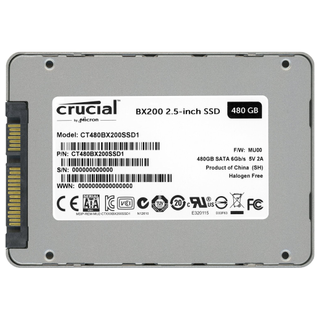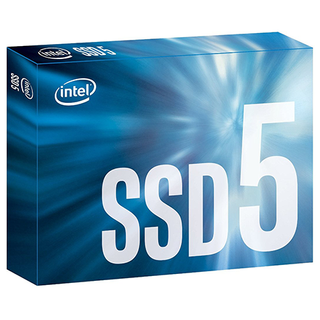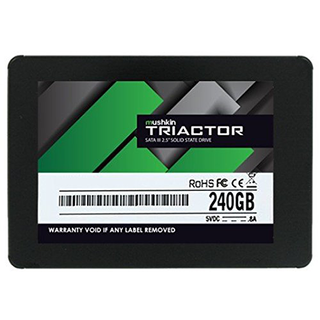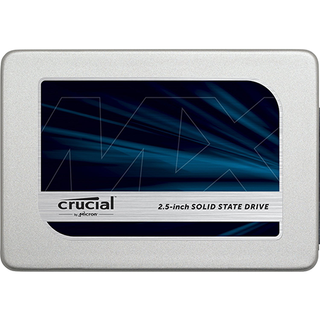Crucial MX300 525GB and 1050GB SSD Review
The Crucial MX300 has moved out of the limited edition cycle and is now a retail, mainstream product. Armed with Micron's new 3D TLC, the highest density flash available, the series could redefine the mainstream SSD market with a new low price point.
Why you can trust Tom's Hardware
Comparisons And Benchmarks
Comparison Products
The Crucial MX300 is coming to market in the midst of a flood of very good, low-cost new SSDs. TLC NAND has taken over the mainstream market. Performance has decreased, but at the same time, software and hardware features have increased. Technologies like dynamic single-level cell (SLC) caches and direct-to-die writes increase the random and sequential write performance to the native TLC.
In the coming weeks, many of the products in this entry-level group will move to the mainstream product category simply because they all have a DRAM buffer to cache the flash translation layer map. The emerging entry-level tier omits the DRAM buffer. We will have a review and a dedicated article in the future covering the DRAM-less products.
All of the products used for this review utilize TLC flash and fall into the entry-level and mainstream segment. For the last couple of years, the Samsung 850 EVO dominated the market with a mainstream price but enthusiast-level performance. The 850 EVO's price has bounced around over the last couple of months. Samsung now offers the 750 EVO with planar NAND to service the entry-level market and, as expected, the 850 EVO's price has slowly crept up in some capacities. The price increase opened the door for other products to fill the entry-level space.
The new Sk Hynix SL308 is one of the closest competitors to the 850 EVO 500GB, but new products from Mushkin and Intel are not far behind, either.
The Crucial MX300 is the first non-Samsung consumer-focused SSD to utilize 3D NAND flash memory. Let's investigate how the MX300 fares on equal footing compared to other 512GB-based products.
Sequential Read Performance
To read about our storage tests in-depth, please check out How We Test HDDs And SSDs. Four-corner testing is covered on page six of our How We Test guide.


Sequential read performance was trivial until the recent move to lower cost 4-channel flash controllers. 8-channel controllers on previous generation products still deliver very high sequential read performance. That is evident by the two leaders in this test, the 850 EVO and Trion 150.
The Crucial MX300 1TB failed to take the top position when compared to products with half of the available capacity. The MX300 525GB, the model we want to compare to the other similar products, fell flat in this test and occupies the bottom position. We've tested other drives with worse sequential read performance, but that was back when the SATA 3Gb/s interface was dominant.
Sequential Write Performance


The first thing you notice in the sequential write tests are the wavy performance results with many of the products. The inconsistent performance is due to the SLC-like layer losing the ability to cache incoming data. The MX300 uses a dynamic SLC cache layer, so as long as you do not have a lot of data on the drive, you will have a fairly large buffer. The large buffer shines through in this test, and we see the MX300 on the upper tier of the performance chart. The drives still fall below the mighty Samsung 850 EVO 500GB.
Random Read Performance



There are a few negative aspects to using a large die size. The page and block size scales with the increased capacity, so more data must pass through the read, modify and write cycle. It takes longer to erase the page, and that leads to latency, but the negative aspects do not stop there; SSDs are fast because they read and write to several die at the same time. With the larger die, it takes less NAND to reach high capacities. When you limit the number of die, you lower the potential for striking a large number of the die during the same operation.
Samsung still offers the only low-cost consumer SSD that can achieve over 10,000 random read IOPS at a queue depth of 1. I'm not sure why Crucial didn't make this level of performance the entry target point for new 3D products. It boggles my mind that a company, at this stage of the SSD game, would bring a mainstream SSD to market without hitting the same performance threshold that Samsung achieved more than two years ago.
Random Write Performance



The new Crucial MX300 leverages its quad-plane NAND to deliver high random write performance. In time, we hope a new 8-channel controller emerges to really extract the most performance out of Micron's quad-plane 3D flash.
One of the challenges facing NAND fabs is being the first to set new trends. Sometimes you have to take a step back to move forward and progress a technology. The early, low capacity MX300s were the step back that was required to progress. The newly announced MX300 2TB with 2100GB of raw storage should give us a better glimpse of what the new 3D flash is really capable of because it features the same number of NAND die as many of the comparison products.
80 Percent Sequential Mixed Workload
We describe our mixed workload testing in detail here, and describe our steady state tests here.
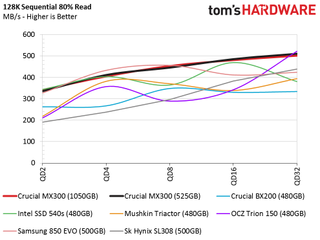
The new 3D TLC flash looks very promising in some tests. Mixed workload performance is good with both sequential and random data. The MX300 scales better than most existing SATA products. Examining performance is like looking through one perforated picture to see another. The first layer, the 100% read or write tests, is what most see, but the second layer is what we want to see. This is where users find the long-term performance traits that have a direct link to the user experience.
80 Percent Random Mixed Workload
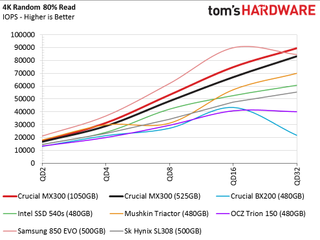
The random mixed workload performance means a little more to us than the mixed sequential test we examined above. We can use this test to predict performance in most of the real-world application tests that will come later in this review. Again, the MX300's scale very well as the queue depth increases, but at queue depth 2, as well as the higher depths, the MX300 trails the 850 EVO.
Sequential Steady-State



In this example, we can show, definitively, how the number of NAND die increase performance. On paper, the MX300 525GB delivers the same performance as the 1050GB model. If that were true, then every test with the two MX300 SSDs would have identical results. The MX300 525GB features 12 NAND die while the 1050GB features 24, and both have the same number of die per package. The Samsung 850 EVO, as well as many of the other products in this review, features 32 total die. Even with a 2x increase in total capacity, the 1050GB MX300 is at a disadvantage during parallel IO operations. We would need an 8-channel controller with a raw capacity of 1536GB to measure the die performance head-to-head. Sadly, Crucial hasn't announced a 1.5TB product yet.
The chart shows just how much of a difference the die count makes. The MX300 525GB is one of the worst drives in this test, but the MX300 1050GB is the best.
Random Steady-State


The 4-channel controller limits the MX300 SSDs at almost every turn. The two drives deliver exceptional steady-state random IOPS for a TLC-based consumer SSD. There are a number of NVMe SSDs on the market, so I still wouldn't use either drive in a high-performance RAID array. We are excited to see what Micron's 3D flash can do with NVMe, which removes the interface bottleneck.
Current page: Comparisons And Benchmarks
Prev Page Specifications And Features Next Page Application PerformanceStay On the Cutting Edge: Get the Tom's Hardware Newsletter
Get Tom's Hardware's best news and in-depth reviews, straight to your inbox.
-
hannibal Nice! Competition to 3d nand is just arriving! The Samsung did have monopoly too long time, now there is competition ones more.Reply -
alextheblue Drives like this don't appeal as much to the enthusiast directly, but they still benefit everyone. Performance is plenty good for most mainstream systems, and as cost per GB decreases they displace HDDs in more OEM systems. This is great because it makes it a lot easier to suggest an SSD model to budget-minded purchasers. We're still not quite where I want to be, but getting there. In the not-so-distant future I can envision building a system with a next-gen NV boot drive and 3D TLC storage drive(s), taking the place of my current SSD/HDD setup.Reply
Oh, and I'm really hoping the cable part of the PCIe 4.0 standard takes hold. I'd rather go that route than multiple M.2 drives. -
bit_user Thanks for the benchies, Chris. I wish the SSD Charts would still be getting updated! (hint, hint)Reply
BTW, I always liked the end-to-end data protection features in Crucial's MX series. To my knowledge, they and Intel's 500-series drives are the only ones to offer this in the consumer segment. Is that (still) correct?
-
CaedenV Man, I take my eyes of the SSD segment for a little bit and the whole landscape changed! I bought all of the SSDs in my house back when they were ~$1/GB. For what I paid for my 500GB of SSD storage I could be looking at 2TB next month. That is just crazy.Reply
I guess the real question in my mind is when I rebuild my rig in ~2 years will I go for a 500GB-1TB performance m.2? Or a larger 2TB SATA drive? Or, if things keep droping in price like this will I be able to afford both?
Or better yet, will these drop in price enough to start replacing HDDs in my NAS box? Hmm... decisions decisions. -
bit_user Reply
The next 2 years will make the previous 2 years look static, by comparison. Expect $/GB to drop much further, and significant performance improvements. nvDIMMs will be on the scene, too.18552184 said:Man, I take my eyes of the SSD segment for a little bit and the whole landscape changed!
...
I guess the real question in my mind is when I rebuild my rig in ~2 years will I ...
BTW, M.2 doesn't necessarily connote NVMe. Although, by the time you upgrade, it'll probably be the norm. -
10tacle I have the 500GB EVO 850 and am happy with it, but if I were looking for a new SSD, the 1050 would be on my short list for a 1TB drive. Absolute raw performance numbers are not be as important to me as having that extra 50GB which is an entire Steam game install these days.Reply -
c0rr0sive I can't wait for the day that I can replace all my 4TB and 8TB disks with some solid storage, right now I can either go with enterprise grade disks for $7800, or go the SSD route for about $9800. Soon, hopefully soon it will be cheaper to go SSD for my needs.Reply -
CRamseyer The MX300 2TB is coming out of testing tomorrow morning. It will be interesting to see it compares to other products shipping today.Reply
As always, thanks for reading and the comments.
